About 90% of Organ Pipe Cactus National Monument is designated wilderness, so you’ll be stepping into a remarkably intact Sonoran Desert. You’ll want to time your trip carefully—season, access roads, and services matter—and learn which roads and trails match your vehicle and fitness. Start with the Kris Eggle Visitor Center and a map, then plan hikes, drives, and where you’ll sleep; keep going to see what to pack and how to stay safe near the border.
Where Organ Pipe Cactus National Monument Is Located
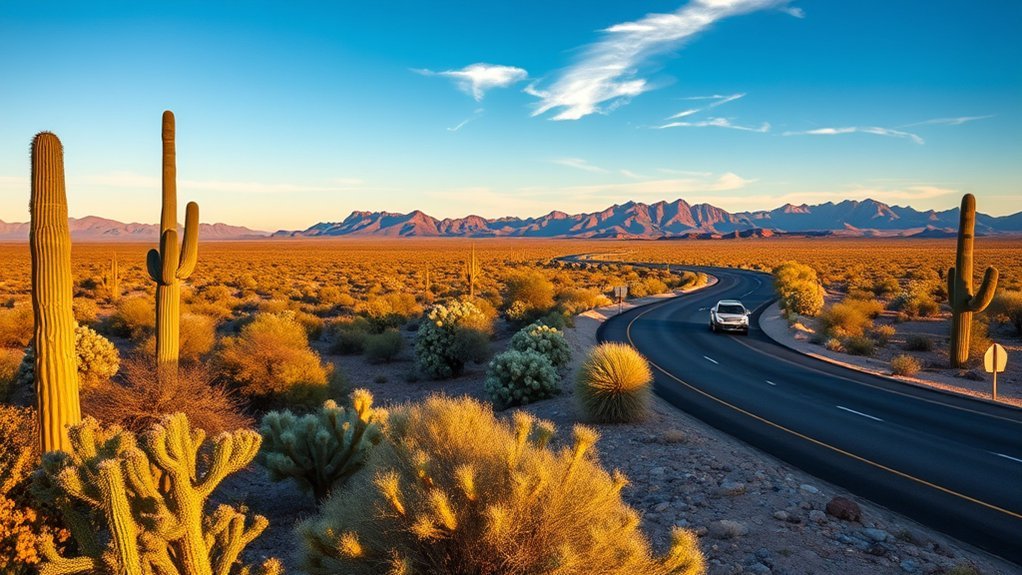
Organ Pipe Cactus National Monument sits in southern Arizona near the U.S.–Mexico border, centered around the small town of Ajo. You’ll find the monument covering 516 square miles of the Sonoran Desert, with over 95% managed as Wilderness to protect fragile habitats. It’s about 130 miles from Tucson, reachable via scenic Highway 86, so plan a straightforward drive into remote desert terrain. The site holds the highest concentration of organ pipe cacti in the United States, a primary reason it earned designation as a UNESCO Biosphere Reserve for ecological value and biodiversity. When you arrive, you’re entering a protected landscape where conservation priorities guide access, interpretation, and any activities you choose to pursue.
Best Time of Year to Visit
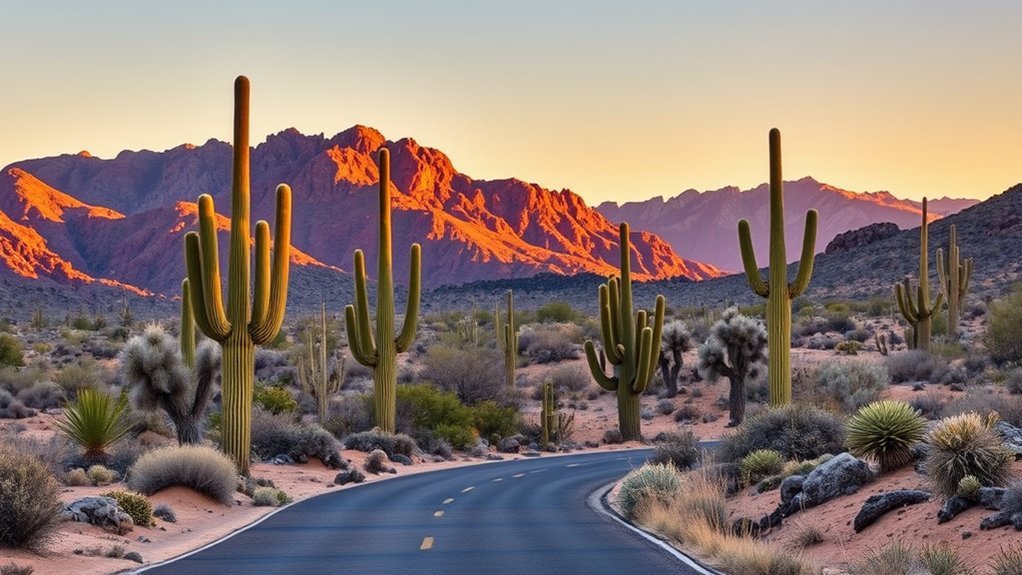
Plan your trip for winter and spring—November through March offers comfortable daytime highs in the mid-60s to low 80s, and March–April brings spectacular blooms. You should avoid summer when temperatures often exceed 100°F, making hiking hazardous. For the best experience, start hikes early and aim for late-afternoon visits to catch dramatic desert sunsets.
Winter and Spring Months
Because daytime temperatures settle comfortably in the mid‑60s to low‑80s from November through March, you’ll find winter and spring the best time to explore Organ Pipe Cactus National Monument for hiking and outdoor activities. These winter and spring months give you ideal hiking conditions and pleasant daytime temperatures that make trails accessible and safe. Early morning visits let you enjoy cooler air, wildlife activity, and solitude. Spring (March–April) brings blooming wildflowers and cacti, transforming the landscape.
- Feel awe at sweeping desert blooms.
- Savor cool, quiet mornings on the trail.
- Catch dramatic sunsets without oppressive heat.
- Relish comfortable outdoor activities and clearer skies.
Plan mornings for longer hikes, afternoons for scenic drives and sunset viewing; it’s the best time to visit.
Avoiding Summer Heat
If you want comfortable, safe outings, avoid the summer months when temperatures regularly top 100°F; visit between November and March instead, when daytime highs sit in the mid‑60s to low‑80s. At Organ Pipe Cactus National Monument, that comfortable climate lets you hike, photograph and drive without risking heat illness. Plan early morning hikes to catch cool air and sunrise, and save scenic drives for late afternoon to enjoy sunsets. Spring brings blooming wildflowers and vivid cactus blooms, especially March–April. Avoiding heat in summer preserves safety and enjoyment.
| Activity | Best Time |
|---|---|
| Hiking | Early morning, Nov–Mar |
| Scenic drives | Late afternoon |
| Wildflower viewing | March–April |
| Avoiding heat | Skip summer temperatures |
How to Get There From Tucson and Phoenix
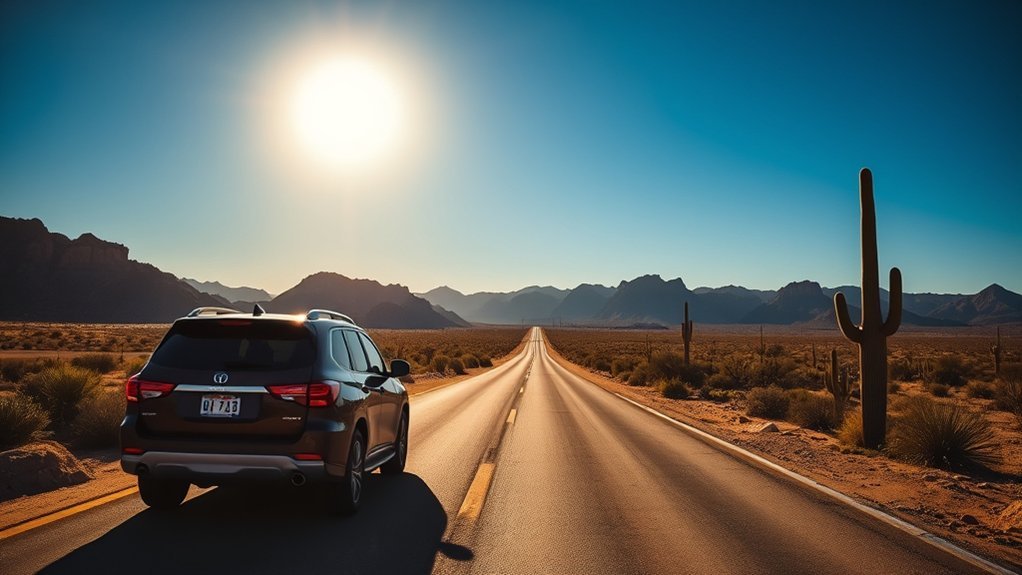
From Tucson, you’ll reach Organ Pipe Cactus National Monument in about two hours by taking scenic Highway 86 west through Ajo, while from Phoenix expect roughly a 2.5-hour drive via I‑10 South to I‑8 West and then Highway 85 South to Ajo; stock up on gas and supplies in Ajo, know cell service is minimal in the monument, and note the park entrance is near the Lukeville border crossing, which reopened in January 2024. You’ll enter park boundaries after Ajo on a quiet desert drive. Plan fuel and water, print maps, and let someone know your itinerary. The Pipe Cactus National Monument requires self-reliance; your visit to Organ Pipe rewards preparedness.
- Anticipation as the desert unfolds
- Quiet that feels sacred
- Relief when you reach Ajo
- Awe at the boundary gates
Entry Fees, Passes, and Park Hours
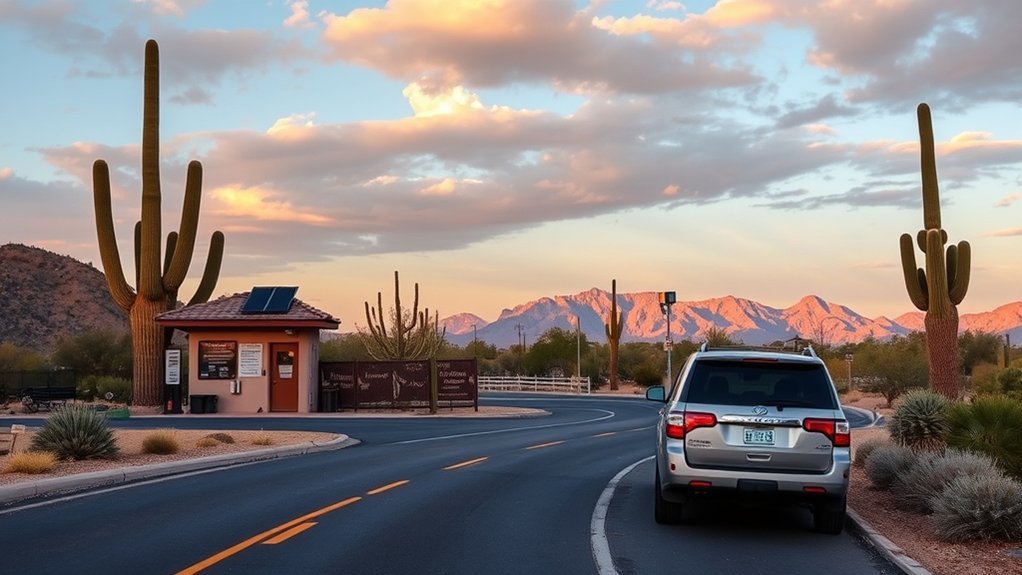
After you’ve planned your route and supplies, take a moment to sort out entry fees, passes, and hours so nothing catches you off guard. Entry fees are $25 per vehicle for a seven-day pass or $15 per person. If you visit multiple parks, consider the America the Beautiful pass ($80/year) for unlimited NPS access. The monument itself is open 24 hours, so you can plan dawn or night drives, but the visitor center’s hours are limited; it operates 9 am–5 pm and is closed Tuesdays and Wednesdays, which can affect logistics. Aim for the ideal season, November–March, when temperatures are milder. Carry proof of payment or your pass, check seasonal advisories, and schedule any ranger interactions for visitor center open days.
Kris Eggle Visitor Center and Ranger Resources
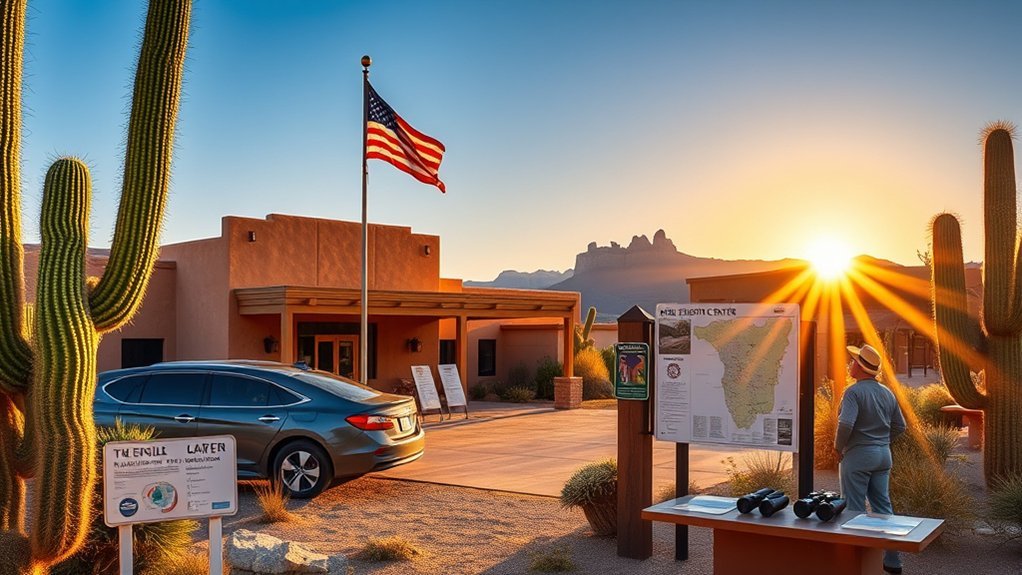
When you arrive, head straight to the Kris Eggle Visitor Center — it’s the gateway to maps, exhibits, and the practical information you’ll need to explore Organ Pipe Cactus National Monument safely. You’ll find park rangers ready to answer questions, give trail advice, and brief you on safety guidelines and border alerts. The center (open 9 am–5 pm, closed Tue–Wed) offers educational resources about the organ pipe cactus and other flora and fauna to enrich your visit.
- Feel the awe of seeing rare desert life explained clearly
- Gain confidence from ranger guidance before you hike
- Connect emotionally with the landscape through exhibits
- Leave informed about border-related safety precautions
Use the center as your planning hub.
Scenic Drives: Ajo Mountain Loop and Puerto Blanco Drive
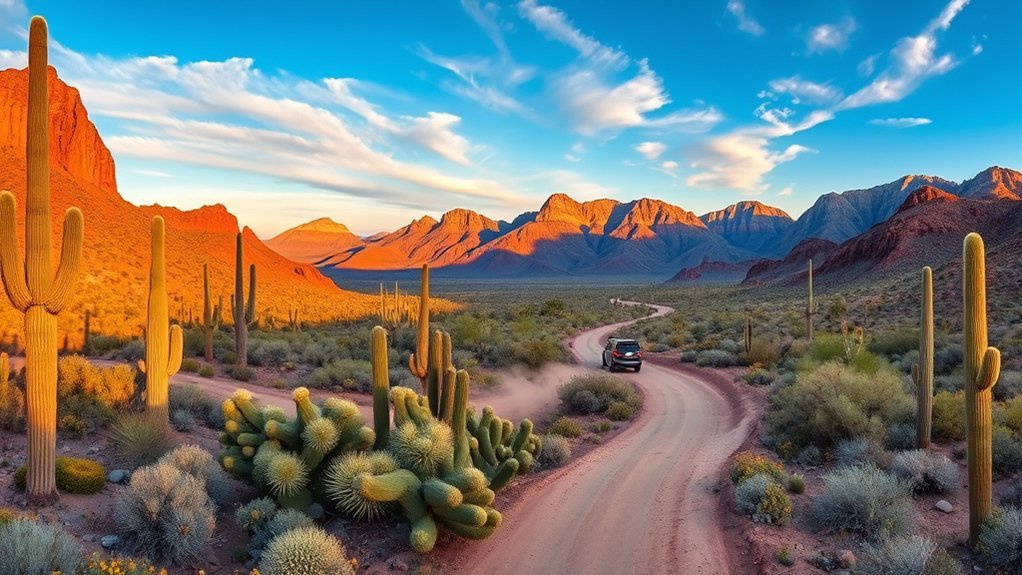
Having picked up maps and advice at the Kris Eggle Visitor Center, head out onto the park’s scenic drives to see organ pipe cactus and desert vistas from the comfort of your car. The Ajo Mountain Drive is a 21-mile scenic loop that takes about two hours with stops; follow pullouts for stunning vistas of the desert landscape and interpretive signs explaining flora and geology. Puerto Blanco Drive is a 37-mile loop and more rugged—use a high-clearance vehicle for certain sections and confirm conditions at the Kris Eggle Visitor Center, since heavy rain can make parts impassable. Drive in late afternoon for dramatic light and sunset views, and watch for wildlife along both routes from your vehicle to minimize disturbance.
Top Hikes and Short Walks to Try
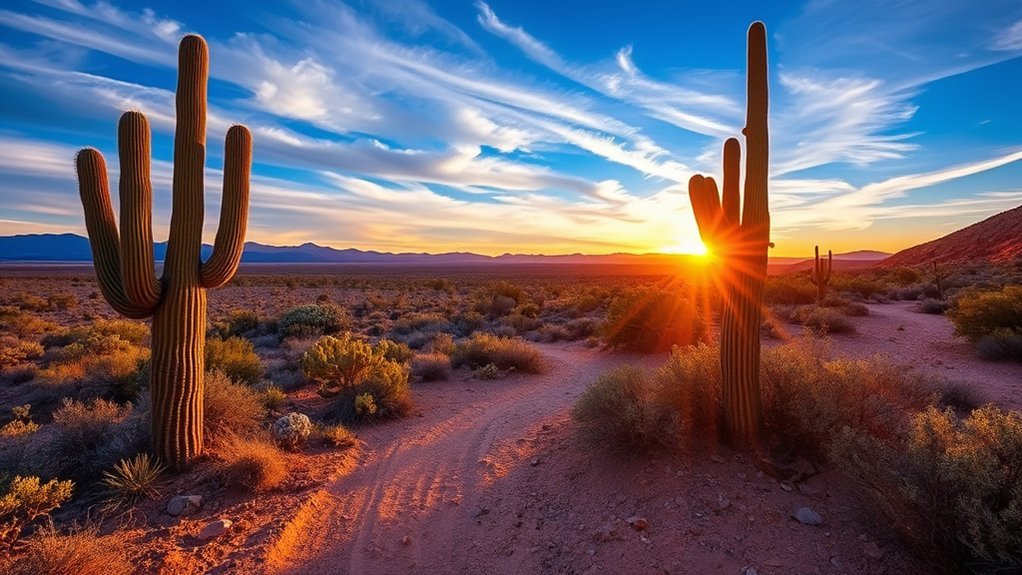
Choose a hike that matches your energy and experience—Organ Pipe offers everything from easy family walks to strenuous backcountry treks—so you can see organ pipe cactus, creosote flats, and dramatic rock formations up close. You’ll find short, memorable outings and longer challenges. The Desert View Trail is an easy 1.2-mile round trip with scenic views ideal for families and quick cactus encounters. For a tougher day, the Bull Pasture Trail is a 4-mile round trip that rewards you with panoramic desert vistas. Arch Canyon Trail (1.2 miles) leads to a natural arch perfect for photos. Drive the Ajo Mountain Drive and hop out at pull-outs for short walks. Always carry water, wear sturdy boots, and watch for desert flora and fauna.
- Family-friendly vistas
- Dramatic photo spots
- Challenging rewards
- Intimate desert encounters
Camping Options and Nearby Lodging
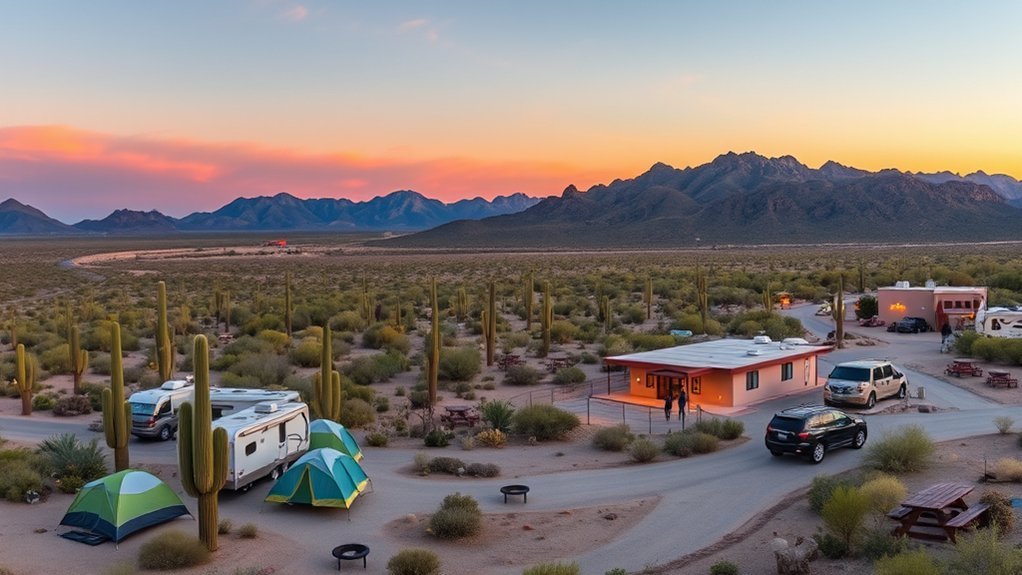
After you’ve mapped out the trails you want to tackle, plan where you’ll sleep — Organ Pipe offers a range of options from full-service sites to primitive backcountry spots. You can choose between Twin Peaks Campground (174 RV sites, 34 tent sites) at $20 per night with visitor amenities like flush toilets, solar showers, potable water and an RV dump, or Alamo Campground’s primitive tent-only sites at $12 per night. For no-fee options, free dispersed camping is available at nearby Gunsight Wash BLM. If you prefer a bed, the closest lodging is in Ajo, which has a few hotels and restaurants, or Gila Bend, which offers more hotel choices. Lukeville has no lodging, so plan ahead.
Safety, Wildlife, and Border Considerations
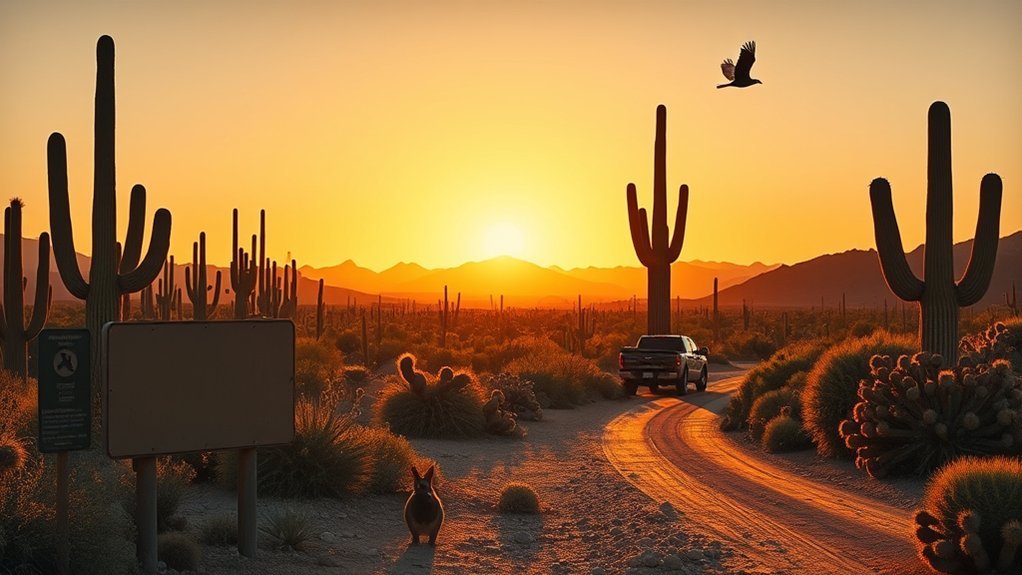
Because Organ Pipe sits along the international border, you should stay alert and follow Park Service guidance for your safety: lock your vehicle, hide valuables, stick to marked trails, carry ID, and be ready for visible Border Patrol activity. You’ll respect border realities and reduce risk by obeying National Park Service rules and using common sense. Keep identification accessible; encounters with Border Patrol are possible and lawful. Observe wildlife from a distance — javelinas, desert tortoises, coyotes and mountain lions deserve space. Don’t feed animals or approach them. Remember the park’s past tragedies and treat personal safety seriously.
Because Organ Pipe borders Mexico, stay alert: lock vehicles, carry ID, stick to trails, respect wildlife and Border Patrol.
- The desert is beautiful but unforgiving.
- Border activity can surprise you.
- Wild animals are not pets.
- Follow NPS guidance for safety.
Practical Packing and Preparation Tips
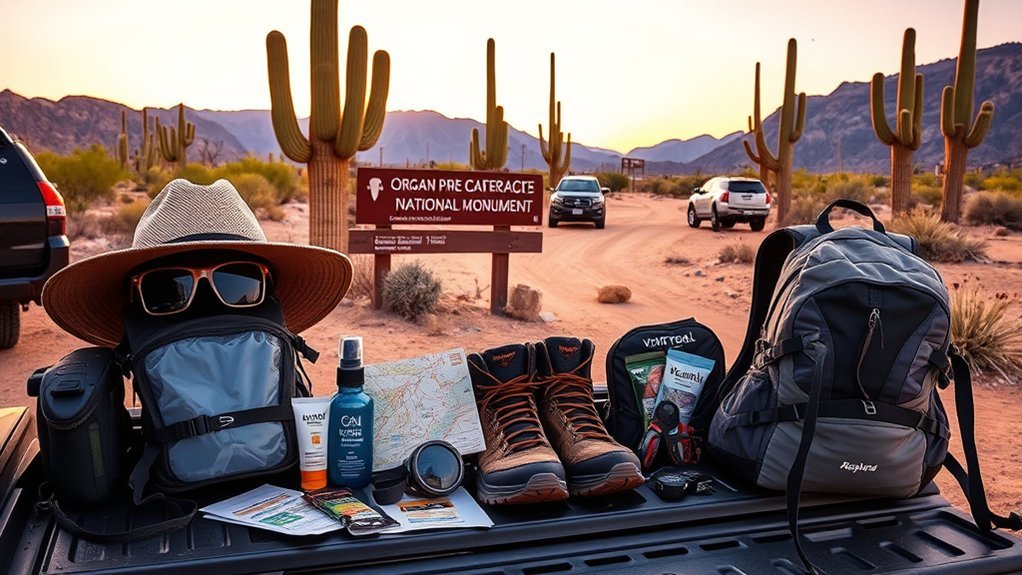
Now that you’re aware of safety and border realities, preparing the right gear will keep you comfortable and alive in the desert. Bring at least one gallon of water per person per day, plus electrolyte packets for longer hiking spells. Pack light, breathable layers for daytime and a jacket for cooler evenings—temperatures swing rapidly after sunset. Essential gear: wide-brimmed hat, sunglasses, sunscreen, sturdy hiking boots and a basic first-aid kit. Plan routes, tell someone your itinerary, and carry a map and charged phone or GPS. Include a camera or binoculars to observe wildlife and capture the stark scenery. Travel light but deliberate: every item should earn its place in your pack to support safety, comfort, and responsible desert travel.
Frequently Asked Questions
When to Visit Organ Pipe National Monument?
Visit between November and March for the best seasons; weather conditions are mild, peak times are winter and spring. You’ll get visitor tips: early hikes, wildlife sightings, local events, and excellent photography opportunities at sunset.
What Is There to Do at the Organ Pipe Cactus National Monument?
Birds of a feather flock together — you’ll hike scenic trails, drive scenic drives, enjoy wildlife viewing, join ranger programs, do star gazing, find photography spots, and explore cultural history, all while savoring breathtaking desert panoramas.
How Much Does It Cost to Get Into Organ Pipe Cactus National Monument?
You’ll pay $25 per vehicle or $15 per person; annual passes waive fees. Check for group discounts and senior rates; look for free days. Payment options are at entrance stations — expect limited cell service for cards.
Is It Safe to Visit Organ Pipe Cactus National Monument?
Yes — you can visit safely, as long as you stay on marked trails, follow park regulations, heed wildlife safety and desert hazards, use visitor facilities, know emergency services, take health precautions, and practice good trail safety.
Conclusion
Plan your trip between November and March when temperatures and wildflowers cooperate, and drive Highway 86 through Ajo with water, maps, and supplies. Entry is $25 per vehicle for seven days; stop at Kris Eggle Visitor Center for current conditions and ranger advice. Explore scenic drives, short hikes, and campsites, but stay aware of wildlife and possible Border Patrol encounters. Consider the theory that Organ Pipe’s isolated range helped unique cactus evolution—come see if the landscape proves it.

